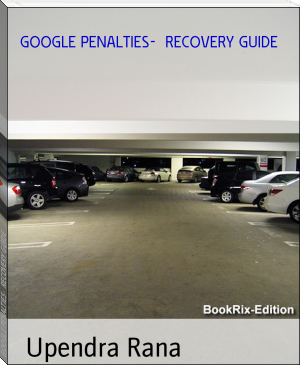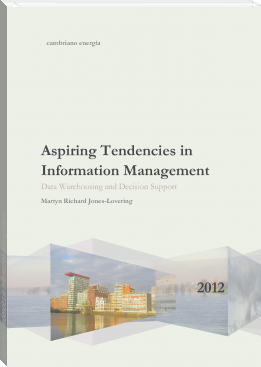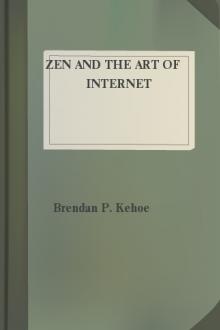GOOGLE PENALTIES- RECOVERY GUIDE, Upendra Rana [the read aloud family .TXT] 📗

- Author: Upendra Rana
Book online «GOOGLE PENALTIES- RECOVERY GUIDE, Upendra Rana [the read aloud family .TXT] 📗». Author Upendra Rana
To make things a bit easier for you, in the case of a manual penalty, in the message you receive from Google you may be given some examples of problematic links. Don’t take those few examples as the source of your problem. They are only indicative and only disavowing them won’t solve your problem. These are just examples meant to give you a
“flavour” of the types of links considered unacceptable by Google. As stated, the disavowing process is a time consuming one. Therefore, you can walk blindly through the lawn of unnatural links trying to correctly identify the ones you’ve been penalized for or you can use tools to quickly outline the links that caused the penalty.
You Need to Remove Links to Escape Penguin.
A lot of controversy hovers over this issue. Yet, instead of arising even more controversy, making all sort of assumptions and beating around the bush without any tangible results, let’s go straight to the source and see what Google has to say on this matter.
It′s always a good idea to clean up unnatural links pointing to your site. Matt Cutts reiterated this whenever he got the opportunity. In an interview from October 2012, he takes it a step further and states that, in order to benefit from this tool, link removal is mandatory and you cannot recover from a penalty with just a disavow file, because the system simply doesn′t let you:
″Google can look at the snapshot of links we saw when we took manual action. If we don’t see any links actually taken down off the web, then we can see that sites have been disavowing without trying to get the links taken down″, said Matt Cutts.
Yet, on a hangout from February 2015 John Mueller from Google was asked whether it was better to remove or disavow when doing a
Penguin cleanup. He answered that “Penguin is an algorithm, so it’s not really going to try to read your emails and figure out if you’re doing the right thing in trying to get that cleaned up. So, with regards to algorithms that look at these links, obviously not having those links on the website is a great thing because then we don’t have them to take a look at. If they’re in the disavow file and we’ve recrawled them like that, then obviously they also won’t be used for that algorithm. But, past that, it’s not going to try to make any judgment calls as to whether or not you tried to clean it up or not.”
Therefore, from this point of view, link removal looks more like a recommendation and not a must to.
This thing was reconfirmed in a hangout from October 2013. When Penguin Algorithm was brought into discussion, the same John Muller says that “with regards to deleting them (links) or disavowing them, generally speaking if you have the ability to delete those links or add a nofollow I’d personally recommend that, because then you’d essentially be helping to clean up this issue overall. But, if you don’t have the ability to have those links removed or you can’t contact the webmaster…the site has been stale for years now…those kind of issues…using a disavow file is fine.”
If I Disavow Links to My Site Google Will Automatically Label Me as a Webspammer
This statement is as false as it can be. The purpose of this tool is to help you solve a problem that is unnatural link related. This, indeed, should be used with caution and only if you are sure of what you are doing. Yet, using it will not put you on Google’s spammers list. It just allows you to tell Google to nofollow a list of links that you cannot control.
You Should Always Disavow at Domain Level
A lot of fuss has been made on this theme and weather disavowing at a domain level is the right way to do things or not hasn’t been cleared out. Yet, in a previous post, we had some great experts sharing with us their experience in disavowing and one of the topic they tackled was the disavowing process at a domain level.
Mark Porter, SEO Manager at ScreamingFrog.co.uk, in an interview that he gave for an article on our blog, came with an interesting point of view on this. He says that while this may be true 95% of the time, there are some exceptions where it doesn’t make sense to disavow a link at domain level. For example, perhaps you have a client who used to send out press releases with multiple anchor text links in them, which got picked up or syndicated on a decent high value site. It’s usually best to disavow these at URL level in case they receive natural pickup from these sites further down the line.
On the other hand, Krystian Szastok , Digital Marketing Manager @RocketMill, on the same interview, states that the disavow should always be done at a domain level as most websites – especially the spammy ones – will give you many links from the same domain. Directories are a good example, you get a link from your listing and from any type of a category page.
Therefore, there is still room for much discussion regarding the disavow at a domain level. What is sure is that disavowing at a level domain is not an unshakable rule and one should always adapt the disavowing process to each situation in particular.
You Have to Make an Effort to Remove Links
What is not a myth is the fact that you can successfully use the Disavow
Tool, not remove links, and experience a restoration of what’s been lost, as David Cohen states in an interview regarding experts’ opinion on the disavowing process. The removing links process might be one of the most common, and at the same time, harmful myth of all. Removing some or all links in order to restore the organic search visibility and traffic that’s been lost is a bit a paradoxical situation.
Using the Disavow Tool and blindly removing links on a wholesale scale isn’t a smart or a strategic approach to solving the problem, it’s sloppy.
Yet, then again, like in any other situation, it depends on whether the site has a manual action or algorithmic one. Yet, the most shared expert opinion on this is that using just the disavow tool is sufficient and that no efforts need to be made repeatedly trying to get links removed from sites.
The Disavow Tool Does Not Work
We cannot say with certainty whether this statement is more of a myth or a fear of the webmasters. What is sure is that forums and blogs are full with discussions around this topic, with lots of people saying that they’ve used the disavow tool and their rankings did not improve, therefore it doesn’t work! Yet, so many factors may need to be taken into consideration.
Well known Marie Haynes from hiswebmarketing.com brings some light on this matter, listing some factors that can be at play and can be found “guilty” for the changeless ranks. For example, perhaps the site had very few good links and was only ranking well previously because of the power of links that are now being considered unnatural. Or maybe it was disavowed the wrong links. Or perhaps the site is also dealing with other issues such as suppression by the Panda algorithm.
I have seen many sites who have escaped Penguin, or have had a manual link penalty removed, which would not have been able to
succeed without using the disavow tool. As Mary stated, the Disavow Tool is a vitally important one that needs to be used by any site that is suffering because of the presence of unnatural links.
I Can Not Reavow Links That I Already Disavowed.
There is this myth that once you disavow links there is no going back. Yet, if you have added a link to your disavow file in error, or if you change your mind about disavowing a particular link, you can remove the link from your file and reupload it. Theoretically, the next time that Google visits that particular link, it will see that it is no longer in your disavow file and will start counting that link toward your PageRank again. However, as Russell Jarvis mentioned in an interview on our blog, reavow requests take much longer to be recognized as Google takes even stricter precautionary measures in this process to aid combating spammers who are trying to find loopholes. They usually crawl a domain a couple of times before revoking the disavow request.
I Don’t Need to Include Nofollow Links in the Disavow File.
A simple search with the query “disavow nofollow links” generates thousands of results that we could use to write a whole PhD thesis on this matter.
The truth is, that there is not a 100% correct answer to the question of whether one should disavow nofollow links or not. We wrote more about this on a previous post that you might find really useful in this context.
As mentioned before, there are 2 major- contradicting opinions on this:
You shouldn’t disavow No-follow links, as Google says it doesn’t pass any ranking juice to them
You should disavow No-follow links as they might be created using unnatural methods and they could add up in the unnatural link mix.
As mentioned in a previous chapter, the safe bet would be to follow
Google’s Approved tip and disavow only do-follow links.
It Takes Google Up to 3 Months to Process a Disavow file!
Google does not give a fixed or a maximum limit on how much someone should wait for one of the three replies (on manual penalties only):
Yes, we think you are in good shape
No, you still have some work to do
We have processed your consideration request – meaning that they might have found multiple issues, maybe one issue is solved but there are other issues that still need to be checked.
It may take a couple of weeks, a month or more.
As Google representatives say, “this is something where depending on the URL sometimes we crawl them daily, sometimes we crawl them every couple of months. So if you submit a large disavow file or a disavow file that includes a lot of domain entries or just generally includes a lot of different URLs, then that is something that’s going to take quite a bit of time to kind of recrawl all of those URLs naturally and reprocess all of that information.”
Very fast recoveries are usually myths and in those cases something else might have caused the problem. Also, you must know that there is no way through which you can influence the Google Penalty Recovery process externally. Yet, if you feel that it takes too long, you can always ask for more information on the webmaster forum, just to be sure that you’re on the right track.
Google Always Provides Correct Examples of Unnatural Links from Your Sites Link Profile.
It’s important to know that any automatic classification done by any algorithms, as advanced as they might be, has a false positive ratio. And even if Google might have a low false positive ratio, errors can still occur. This is why a manual auditing of your site is highly important. We live in an era of fast solving problems through automated processes. Yet, it is hard to believe that it’s possible for a tool to be 100% accurate. However, Google does require a lot of accuracy when it comes to submitting the disavow file. And this is where the human intervention appears and





Comments (0)